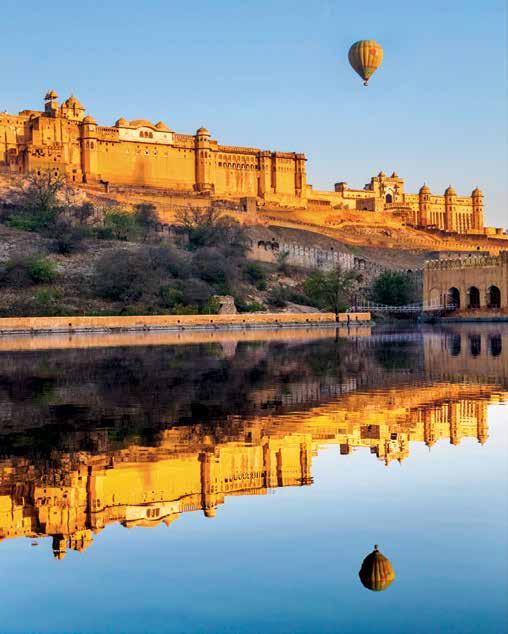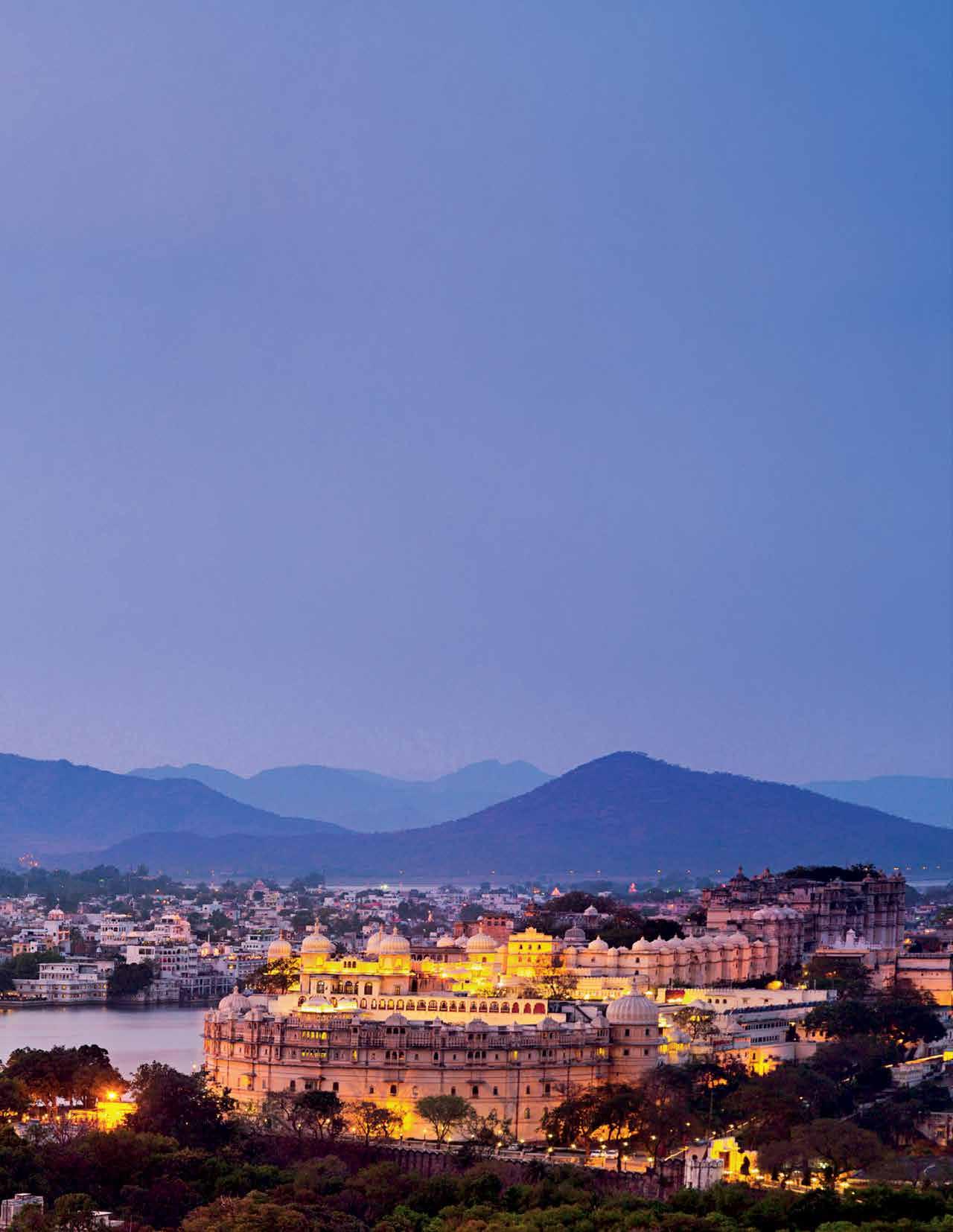
8 minute read
Royal Palaces of India
An Indian Company
Micato India’s home base is in India, not in an office two oceans away. Upon arrival you are given key phone numbers, which you can call anytime, day or night. So, if your Travel Director isn’t in attendance, and you need a prescription filled, a question answered, or a car at your hotel’s front entrance, we’re on-the-24-hour-ball. Plus, Micato is a well-known and respected partner of India’s champion hotels, making life all the sweeter for our guests.
Advertisement
Upgrades
We fly business class in India whenever possible. If—as sometimes is the case—there is no business class, we purchase an extra 12 pounds of baggage allowance per sector, per guest.
We Pick Up the Check, Always
All meals are included everywhere, every day. If you choose to dine at one of your hotel’s restaurants, you’re not—this is very often the case—limited to a buffet or minimal menu. And if you want to sample one of Jaipur’s famous eateries, or follow your Travel Director’s tip on a hip new Delhi café, Micato takes care of the check.
Refreshing Travel
We only use the most up-to-date, air-conditioned vehicles (and our cars and vans are carefully supplied with iced water, hand purifiers, snacks, and whatever you need).
We Pick Up the Tab
Local wine and beer are included with all meals.
Laundry Happily Included
Complimentary laundry service is on us.
Udaipur’s Lake Pichola and its grand City Palace (also seen on this brochure’s final spread), built over the course of 400 years by the Maharanas of the Mewar dynasty. Micato’s Hem Singh (see page 17) says that “My favourite city, outside of Jaipur, of course, is Udaipur: coffee on a private terrace overlooking the lake, a little city exploring—especially the rural areas—and a sunset boat ride followed by dinner on the edge of the lake.”

ROYAL PALACES OF INDIA
16 days Departs Friday, returns Saturday
I
ndia’s grand and gorgeous architectural masterworks have enchanted the West for scores of centuries. Lord Curzon, India’s most astute Viceroy, praised its temples, tombs, and palaces as “the greatest galaxy of monuments in the world.” On this two-week journey to India’s northern heartland, we immerse ourselves in that stellar firmament, visiting the grandest of the subcontinent’s monuments— with an enthralling emphasis on its old and its new palaces, in which, enveloped in luxurious hospitality, we’re happy to say we stay. At Delhi’s Leela Palace; the fabulous Oberoi Amarvilas in Agra, where every window looks out at the nearby Taj Mahal; at the exquisite Rambagh Palace, home of Jaipur’s last reigning maharajah; at Udaipur’s lyric Oberoi Udaivilas; and the Taj Group’s majestic Umaid Bhawan Palace in Jodhpur.
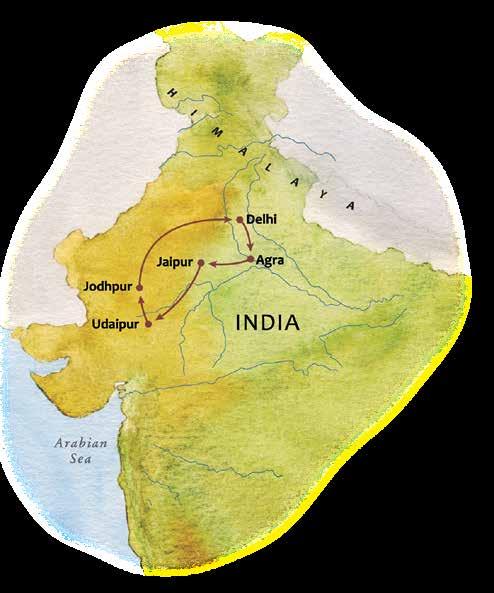
India’s ability to exert power through the sheer charm of its civilization should not be underestimated.
—William Dalrymple
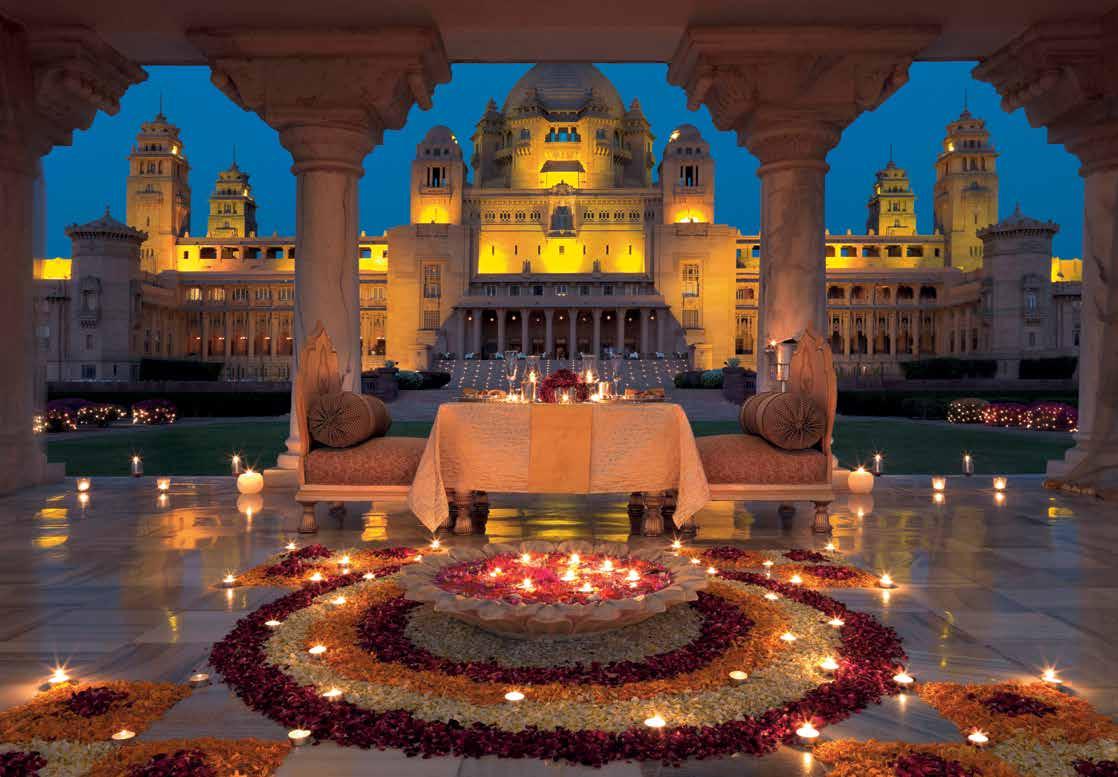
day 1 En Route
days 2–4 Delhi
After a leisurely morning we’ll have an orientation lunch with our Micato Travel Director. Now we’ll delve into swirlingly colourful Old Delhi, rickshawing over to Jama Masjid, one of India’s largest and most impressive mosques (it’s one of the last monuments built by Shah Jahan, whose worldcrowning glory, the Taj Mahal, we’ll soon see).
We’ll visit Humayun’s Tomb (said to have inspired the eagerly inspirable Jahan), pay our respects at the Gandhi Smriti memorial and museum, explore the British Raj’s imposing New Delhi edifices, and mingle with happy pilgrims at giant Gurudwara
Bangla Sahib, a bustling Sikh temple.
The first of our Indian palaces, the Leela, is set in the capital’s Diplomatic Enclave, and beckons with quietude, unabashed luxury, and India’s unceasingly gracious hospitality.
days 5 & 6 Agra A modern toll road takes us to Agra for a couple of days in the sweetly hypnotic aura of the Taj Mahal. Our base is the Amarvilas, a scintillating Oberoi jewel. Every window in Amarvilas looks out at the Taj, less than two thousand feet away, giving us everchanging views of humanity’s greatest artifact* from our beautifully decorated, balconied rooms and from the hotel’s expansive verandas. We’ll make early morning and evening visits to the Taj, wandering in its gardens and under its whitecloud archways. We’ll amble in fascinating Agra Fort (where Shah Jahan was imprisoned for the last years of his life, peering dolefully out at his masterpiece). We’ll visit a marble inlay studio (after seeing the exquisite Taj inlays, we’ll want to know how this marble magic works), returning to the Amarvilas for a swim in its lovely pool, dinner at its top-flight restaurant, making sure to catch a few minutes or hours to contemplate the Taj.
days 7–9 Jaipur
A countryside drive takes us to the fabled Pink City of Jaipur. For more than half a millennium Jaipur’s
Rajput maharajahs were renowned for their regal disdain for rupee-pinching. They spent, played, and built extravagantly; witness our palace, the
Rambagh, home of the last of Jaipur’s rulers, Sawai
Man Singh II. The Rambagh Palace, now a Taj
Group property, regularly lands high on lists of the
World’s Best Hotels, for its frank splendour, its traditionally noble but state-of-the-art comfy rooms, its cool marble corridors, its fountain-misted gardens, its fine dining, and, in the Taj Group custom, its flawlessly alert and cheery service. There is much to see and enjoy in the Pink City, and with our Micato Travel Director at our side, we’ll do our best to take it all in, visiting the vast and fabulously ornate City Palace; hot air ballooning in the early morning as Jaipur awakens; rambling in the Doctor Seussian (but strikingly accurate) 280-year-old Jantar Mantar observatory; and admiring the whimsical Hawa Mahal, or Palace of the Winds. We’ll wander in the mirrored mini-palaces of massive Amber Fort, lunch at the serene Samode Palace a little way outside of town, and spend an afternoon taking a short walk with lovingly cared-for elephants at a private estate, followed by an al fresco lunch or dinner. days 10 & 11 Udaipur
A morning flight takes us to lakeside Udaipur, beloved of
Indians and internationals for its beauty and serenity, its intriguing temples, and its chromatic history—which we’ll experience in the flamboyant City Palace, hilltop home of Udaipur’s Mewar maharanas, who, like their Mughal suzerains, gracefully avoided all things frugal. Udaipur has a Venetian feel, with homes and palaces built by the shores of Lake Pichola, and we’ll take a sunset boatride across the lake to our lodgings, the sublime
*If aliens arrived and demanded proof that our species was worth preserving, we might crank up some Mozart or Beethoven, take them on a chaperoned tour of Shakespeare, but we’d really seal the deal with the Taj. In 1971 India abolished the state subsidies and titles of the maharajahs, rajahs, nawabs, wadiyars, badshahs, and walis of the Princely States that had become part of independent India 24 years before. But some of the families, perhaps especially Jaipur’s, held on to great wealth and prestige.
PREVIOUS PAGE Reflection of the Taj Mahal, Agra. Lord Curzon, Viceroy of India at the turn of the 20th century, wrote that the Taj was “The gem of man’s handiwork, without flaw or blemish, exquisite, irresistible, impossible to criticize, incapable of improvement, the most perfect structure in the world.” (Note that the aesthetically astute Curzon said “the gem of man’s handiwork,” not “a gem.”) OPPOSITE PAGE An invitation to dine like royalty at the Umaid Bhawan Palace in Jodhpur. BELOW Semi-private pool and lounge area at the Oberoi Udaivilas in Udaipur.
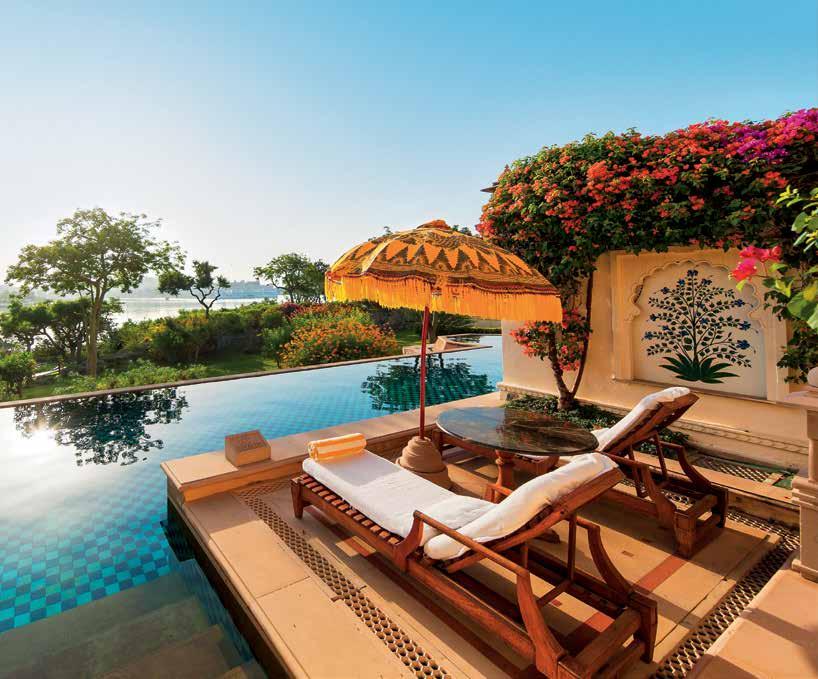
There are some parts of the world that, once visited, get into your heart and won’t go. For me, India is such a place. When I first visited...it was as if all my life I had been seeing the world in black and white and, when brought face-to-face with India, experienced everything re-rendered in brilliant technicolor.
—Keith Bellows

day 15 Back to Delhi and Homeward
After flying back to Delhi, we’ll have day rooms— and night rooms, if necessary for late flights—at the splendid Oberoi Gurgaon, near Delhi’s airport.
day 16 Arrive Home
Oberoi Udaivilas, recently ranked the planet’s second-best hotel by Condé Nast Traveler, and the number one Indian resort hotel by Travel+Leisure. We luxuriate in the grand interconnecting domes and sun-flooded walkways, in the artwork, gardens and spa, reveling in a modern palace in which India’s maharajahs, maharanas, nizams, and assorted nawabs would feel right at regal home.
days 12–14 Jodhpur
We drive northwest towards Jodhpur, stopping for a quiet lunch en route and a visit to the Jain temple complex at Ranakpur before motoring up to the doors of the Umaid Bhawan Palace, fittingly the last and the largest of India’s great palaces. Umaid Bhawan sits among 26 garden acres atop
Chittar Hill, overlooking the Blue City of Jodhpur.
The vast palace—once the world’s largest private residence—now serves as a museum, as the home of the old ruling family, and as a uniquely stately hotel, expertly operated, as always, by the Taj
Group. Our palace rooms are decorated with
Art Deco themes and feature all the luxuries, amenities, and grace notes we’ve come to expect from a Taj hotel. The Umaid Bhawan is, as they say, a destination in itself, but so is Jodhpur; we’ll wander in the Old City, visit monolithic Mehrangarh Fort and the glowing marble cenotaph of Jaswant Thada, and we’ll take a jeep safari through Bishnoi villages (the Bishnoi are a religious group rooted in deep respect for nature), followed by a lovely picnic lunch and a return to the inimitable Umaid Bhawan.
LEFT A nook in the private quarters of Udaipur’s City Palace, a flamboyantly yet engagingly vast complex on the shores of Lake Pichola. BELOW Ballooning at Amber Fort, Jaipur. OPPOSITE PAGE A courtyard in the City Palace, Jaipur. Vast, ornate, sometimes almost whimsically beautiful, City Palace was built in the 1730s by Jai Singh II, one of Jaipur’s long line of swashbuckling, polo-playing, tastefully sybaritic maharajahs.
